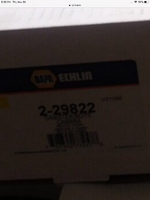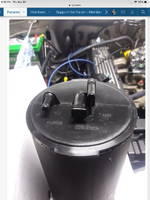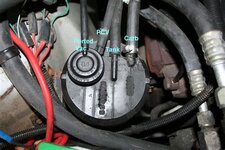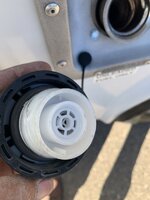Misc. I have a 1985 Jeep CJ7 that needs a new vapor canister part J3239479. Does anyone know if there is a replacement?
You are using an out of date browser. It may not display this or other websites correctly.
You should upgrade or use an alternative browser.
You should upgrade or use an alternative browser.
Misc. I have a 1985 Jeep CJ7 that needs a new vapor canister part J3239479. Does anyone know if there is a replacement?
- Thread starter Tmja6852
- Start date
Misc. I have a 1985 Jeep CJ7 that needs a new vapor canister part J3239479. Does anyone know if there is a replacement?
CJ
Admin
- Posts
- 21,729
- Thanks
- 623
- Location
- Central FL
- Vehicle(s)
- '72 CJ5, 401, T18, D20, D44, D30
'82 CJ8, 258, D300, AMC20, D30

That number is used in many Jeep models. Have you looked on Google, Ebay or Chrysler parts?
J3239479 site:ebay.com - Google
(Link)-> J3239479 site:ebay.com - Google Search -<
J3239479 - Chrysler Canister, canister, vapor. 4.2l eng., eight | Factory Chrysler Parts, Bartow FL
Genuine Chrysler Part # J3239479 (J3239479) - Canister, canister, vapor. 4.2l eng., eight cylinder, four cylinder, six cylinder. 1981-86, 1982-85: export, japan, 1982-86: canada, 1983-86: canada. Ships from Factory Chrysler Parts, Bartow FL
www.factorychryslerparts.com
TSB8C
Senior Jeeper
- Posts
- 802
- Thanks
- 411
- Location
- Cut-n-Shoot, TX
- Vehicle(s)
- 1984 CJ7, 420 HP "ZZ6 EFI" Crate engine, 700R4, D300, Dana30 front, Dana489 rear, 4.56 gears, 4" lift
Any 4-port canister should work if it fits in the space. New or junkyard pull should do.
caveman
Full Time Jeeper
- Posts
- 1,700
- Thanks
- 63
- Location
- Central Maine
- Vehicle(s)
- 88 YJ with a CJ nose, 4.7 Stroker, AW4 transmission, Dana 35 HP front Ford 8.8 rear
I may have one in my storage shed. Been cleaning it out and can't remember if I saved one. Will check tomorrow if I don't forget.
caveman
Full Time Jeeper
- Posts
- 1,700
- Thanks
- 63
- Location
- Central Maine
- Vehicle(s)
- 88 YJ with a CJ nose, 4.7 Stroker, AW4 transmission, Dana 35 HP front Ford 8.8 rear
I still have a few if you're still interested.
SwampRatt
Jeeper
I bought this one from Delorean. Pricy but 4 port just like the one in my 79 that was trashed. I replaced it and the vacuum lines, the gas smell was powerful, and so is the wife’s nose.
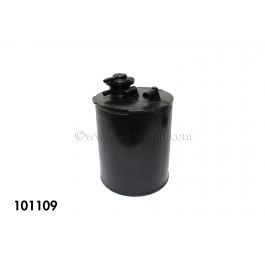
 store.delorean.com
store.delorean.com

CARBON CANISTER
A vital part of the emissions control system in your DeLorean, fuel vapors are routed to this carbon canister. Sometimes a fuel smell can be traced to a damaged carbon canister or to deteriorated rubber blanking caps on the top. It is located in the drive
Belizean
Always Off-Roading Jeeper
- Posts
- 5,995
- Thanks
- 402
- Location
- New Orleans area
- Vehicle(s)
- 84 CJ7 4 banger-owned since new in 1984 bought off truck at dealership - rebuilding 258, T176 with Sniper EFI D300 4:1 Lomax gears Twin Sticked 1 piece axels with locker
TSB8C
Senior Jeeper
- Posts
- 802
- Thanks
- 411
- Location
- Cut-n-Shoot, TX
- Vehicle(s)
- 1984 CJ7, 420 HP "ZZ6 EFI" Crate engine, 700R4, D300, Dana30 front, Dana489 rear, 4.56 gears, 4" lift
I used a GM 215-153 from Amazon for about $90. Similar but not exact to the one Belizean posted. Another option is a generic brand for that GM part number. Amazon has a Fexon for $38. Never heard of that brand. That's why I went with the actual GM part. I have a GM fuel injected engine. Any search for a GM 215-153, or a 911-261 should get you one. The Dorman version would also work.
Look for a mid-90's GM with an 8 cylinder engine.
If you want an original, here's a salvage pull available: CJ Canister
Look for a mid-90's GM with an 8 cylinder engine.
If you want an original, here's a salvage pull available: CJ Canister
Patrick
Senior Jeeper
- Posts
- 949
- Thanks
- 155
- Location
- El Paso, TX
- Vehicle(s)
- 82 CJ5, LS 6.2, NV3550/D300, D44/30
68 CJ5, 350, Muncie/D18, D44/27 under construction
Don’t just replace this component. Many of us don’t understand or simply don’t care about this fuel evaporation control system (hope I named it correctly). There’s more to it than just emissions control. A write up on this topic could enlighten us.
TSB8C
Senior Jeeper
- Posts
- 802
- Thanks
- 411
- Location
- Cut-n-Shoot, TX
- Vehicle(s)
- 1984 CJ7, 420 HP "ZZ6 EFI" Crate engine, 700R4, D300, Dana30 front, Dana489 rear, 4.56 gears, 4" lift
"A write up on this topic could enlighten us."
I'll give it a shot.
Gas evaporates quite easily. In the past, these evaporative vapors were vented into the atmosphere via a vented gas cap. Approximately 20% of all hydrocarbon emissions from a gasoline vehicle are from the gas tank. In 1970, laws were passed prohibiting venting of gas fumes from the tank into the atmosphere. An evaporative control system ("evap") was developed to eliminate this source of pollution. The function of the fuel evaporative control system is to trap and store evaporative emissions from the gas tank and carburetor. In an EFI engine, the throttle body has no bowl or collection of fuel to deal with. This is accomplished by use of a sealed gas cap and a charcoal canister to trap the fuel vapors. The fuel vapors adhere to the charcoal, while other fumes pass right through, until the engine is started, and engine vacuum can be used to draw the vapors into the engine, so that they can be burned along with the fuel/air mixture. This sealed gas cap is so important to the operation of the system, that a test of the cap has been incorporated into many state emission inspection requirements. Gas tanks were also redesigned. The tank has to have space for the vapors to collect so that they can then be vented to the charcoal canister. A purge valve in the canister is used to control the vapor flow into the engine. The purge valve is operated by engine vacuum in a carbureted vehicle, or via the ECM in an EFI controlled engine. With a carbureted engine, the canister usually has four connections. The first is for the fumes vented from the gas tank. The second is a line to the carburetor bowl. The third is the purge connection that is attached to a ported vacuum source on the engine. The fourth is a fresh air intake so when the purge control opens the valve to draw in gas fumes, a fuel/air mixture is available and to also allow air to enter the tank as fuel is drawn out. When used with an EFI engine, the second connection to the carburetor is obviously not needed, so a three port canister is usually used (tank vent, ported vacuum source, and fresh air). In addition, the purge control valve may be electronically controlled by the engine ECM rather than plain vacuum operated.
Now on some vehicles, including our beloved CJs, this system also includes a check valve to prevent gasoline from exiting the tank through the tank vent connection and spilling into the canister's "tank" port by placing a check valve in that line between the two. In the event of a rollover (or severe off camber incline) this check valve closes and blocks gas from exiting the tank. This is not required for proper functioning of the evap system, but it is a safety feature any off roader should have in place.
Now if your state doesn't require any emissions testing, then you could theoretically just get a vented gas cap (good luck with finding that), cap off the tank vent and the carb vacuum port, and eliminate this evap system altogether. But beware - you will deal with the smell of gas fumes venting through the gas cap, especially in warmer weather. This will also decrease fuel mileage as you are losing burnable gas fumes into the atmosphere that you could be drawing into the engine instead.
One common problem with this system is that the purge valve goes bad (stuck open) and engine vacuum draws fuel directly into the intake system. This enriches the fuel mixture and will foul the spark plugs. Most charcoal canisters also have a filter that should be replaced periodically. In a sealed type canister, the entire unit must be replaced when the filter is no longer functional. This system should be checked whenever fuel mileage drops, the engine is running too rich, gas fumes are detected (usually by smell), and/or the canister leaks fuel. Another common problem is that the purge valve can become stuck shut, preventing the engine from drawing in the collected fumes, and possibly causing premature failure of the filter (think "waterlogged" but with gas), or perhaps even a vapor lock condition in the gas tank (the fresh air inlet is blocked).
In my case with an EFI engine, I have a three port canister (tank vent, fresh air, ported vacuum). The ECM that came with my engine does not have electronic evap control. So a ported vacuum source on the throttle body handles the job. I also included the rollover check valve between the tank's vent and the "tank" connection on the canister. It doesn't really matter where you mount the canister. It is usually in the engine bay. But if space is an issue, it can be moved. Mine is mounted at the rear driver's side behind the inner fender well (where you access the bolts holding the taillight on. It is just below the check valve mounted above it. This was done due to space limitations under the hood with my dual battery, OBA pump, SBC with headers, alarm siren, secondary fuse panel, extra relays for the dual electric fans, etc. I then have a metal line (piece of metal fuel line) with a short length of rubber vacuum hose at each end travelling along the left side frame rail to the engine bay to connect to the throttle body.
If someone has more to add, please do.
I'll give it a shot.
Gas evaporates quite easily. In the past, these evaporative vapors were vented into the atmosphere via a vented gas cap. Approximately 20% of all hydrocarbon emissions from a gasoline vehicle are from the gas tank. In 1970, laws were passed prohibiting venting of gas fumes from the tank into the atmosphere. An evaporative control system ("evap") was developed to eliminate this source of pollution. The function of the fuel evaporative control system is to trap and store evaporative emissions from the gas tank and carburetor. In an EFI engine, the throttle body has no bowl or collection of fuel to deal with. This is accomplished by use of a sealed gas cap and a charcoal canister to trap the fuel vapors. The fuel vapors adhere to the charcoal, while other fumes pass right through, until the engine is started, and engine vacuum can be used to draw the vapors into the engine, so that they can be burned along with the fuel/air mixture. This sealed gas cap is so important to the operation of the system, that a test of the cap has been incorporated into many state emission inspection requirements. Gas tanks were also redesigned. The tank has to have space for the vapors to collect so that they can then be vented to the charcoal canister. A purge valve in the canister is used to control the vapor flow into the engine. The purge valve is operated by engine vacuum in a carbureted vehicle, or via the ECM in an EFI controlled engine. With a carbureted engine, the canister usually has four connections. The first is for the fumes vented from the gas tank. The second is a line to the carburetor bowl. The third is the purge connection that is attached to a ported vacuum source on the engine. The fourth is a fresh air intake so when the purge control opens the valve to draw in gas fumes, a fuel/air mixture is available and to also allow air to enter the tank as fuel is drawn out. When used with an EFI engine, the second connection to the carburetor is obviously not needed, so a three port canister is usually used (tank vent, ported vacuum source, and fresh air). In addition, the purge control valve may be electronically controlled by the engine ECM rather than plain vacuum operated.
Now on some vehicles, including our beloved CJs, this system also includes a check valve to prevent gasoline from exiting the tank through the tank vent connection and spilling into the canister's "tank" port by placing a check valve in that line between the two. In the event of a rollover (or severe off camber incline) this check valve closes and blocks gas from exiting the tank. This is not required for proper functioning of the evap system, but it is a safety feature any off roader should have in place.
Now if your state doesn't require any emissions testing, then you could theoretically just get a vented gas cap (good luck with finding that), cap off the tank vent and the carb vacuum port, and eliminate this evap system altogether. But beware - you will deal with the smell of gas fumes venting through the gas cap, especially in warmer weather. This will also decrease fuel mileage as you are losing burnable gas fumes into the atmosphere that you could be drawing into the engine instead.
One common problem with this system is that the purge valve goes bad (stuck open) and engine vacuum draws fuel directly into the intake system. This enriches the fuel mixture and will foul the spark plugs. Most charcoal canisters also have a filter that should be replaced periodically. In a sealed type canister, the entire unit must be replaced when the filter is no longer functional. This system should be checked whenever fuel mileage drops, the engine is running too rich, gas fumes are detected (usually by smell), and/or the canister leaks fuel. Another common problem is that the purge valve can become stuck shut, preventing the engine from drawing in the collected fumes, and possibly causing premature failure of the filter (think "waterlogged" but with gas), or perhaps even a vapor lock condition in the gas tank (the fresh air inlet is blocked).
In my case with an EFI engine, I have a three port canister (tank vent, fresh air, ported vacuum). The ECM that came with my engine does not have electronic evap control. So a ported vacuum source on the throttle body handles the job. I also included the rollover check valve between the tank's vent and the "tank" connection on the canister. It doesn't really matter where you mount the canister. It is usually in the engine bay. But if space is an issue, it can be moved. Mine is mounted at the rear driver's side behind the inner fender well (where you access the bolts holding the taillight on. It is just below the check valve mounted above it. This was done due to space limitations under the hood with my dual battery, OBA pump, SBC with headers, alarm siren, secondary fuse panel, extra relays for the dual electric fans, etc. I then have a metal line (piece of metal fuel line) with a short length of rubber vacuum hose at each end travelling along the left side frame rail to the engine bay to connect to the throttle body.
If someone has more to add, please do.
TSB8C
Senior Jeeper
- Posts
- 802
- Thanks
- 411
- Location
- Cut-n-Shoot, TX
- Vehicle(s)
- 1984 CJ7, 420 HP "ZZ6 EFI" Crate engine, 700R4, D300, Dana30 front, Dana489 rear, 4.56 gears, 4" lift
In cases where you have a port to connect to the PCV valve, the canister actually has 5 "ports". The PCV connection is to draw gasses from the crankcase into the canister as well (via the PCV valve), along with the vapors from the gas tank. In these type canisters, your fresh air inlet is in the bottom of the canister rather than being a hose connection on top.
SwampRatt
Jeeper
Bottom fresh air inlet.
Mine is on the drivers side firewall, down kinda low. Just a skosh above the bottom of the inner fender.
The PO at some time hit a soupy mud hole and trashed the vac canister.
IMHO bad choice on location.
Mine is on the drivers side firewall, down kinda low. Just a skosh above the bottom of the inner fender.
The PO at some time hit a soupy mud hole and trashed the vac canister.
IMHO bad choice on location.
Belizean
Always Off-Roading Jeeper
- Posts
- 5,995
- Thanks
- 402
- Location
- New Orleans area
- Vehicle(s)
- 84 CJ7 4 banger-owned since new in 1984 bought off truck at dealership - rebuilding 258, T176 with Sniper EFI D300 4:1 Lomax gears Twin Sticked 1 piece axels with locker
Jeep probably never thought about anyone putting 35s on vehicles back in the day.
Patrick
Senior Jeeper
- Posts
- 949
- Thanks
- 155
- Location
- El Paso, TX
- Vehicle(s)
- 82 CJ5, LS 6.2, NV3550/D300, D44/30
68 CJ5, 350, Muncie/D18, D44/27 under construction
Thanks for taking time, TS.
I thought the gas cap should not be sealed. It has to have a check function or the tank will distort under vacuum. The tank should be kept as close to atmospheric pressure as possible. Positive pressure could lead to fuel spray when uncapping.
I don’t have ported vacuum but an electric purge valve. My ecm lacks a purge signal output. Do you think cycling the purge valve on with an “off idle” signal is a good idea…
How do you suppose the valve is cycled with oem ecm…
I thought the gas cap should not be sealed. It has to have a check function or the tank will distort under vacuum. The tank should be kept as close to atmospheric pressure as possible. Positive pressure could lead to fuel spray when uncapping.
I don’t have ported vacuum but an electric purge valve. My ecm lacks a purge signal output. Do you think cycling the purge valve on with an “off idle” signal is a good idea…
How do you suppose the valve is cycled with oem ecm…
TSB8C
Senior Jeeper
- Posts
- 802
- Thanks
- 411
- Location
- Cut-n-Shoot, TX
- Vehicle(s)
- 1984 CJ7, 420 HP "ZZ6 EFI" Crate engine, 700R4, D300, Dana30 front, Dana489 rear, 4.56 gears, 4" lift
Driver side firewall down low is the default location on CJs. Agree - bad design.Bottom fresh air inlet.
Mine is on the drivers side firewall, down kinda low. Just a skosh above the bottom of the inner fender.
The PO at some time hit a soupy mud hole and trashed the vac canister.
IMHO bad choice on location.
TSB8C
Senior Jeeper
- Posts
- 802
- Thanks
- 411
- Location
- Cut-n-Shoot, TX
- Vehicle(s)
- 1984 CJ7, 420 HP "ZZ6 EFI" Crate engine, 700R4, D300, Dana30 front, Dana489 rear, 4.56 gears, 4" lift
Fresh air inlet, and vacuum when appropriate, vents the gas tank and maintains proper atmospheric pressure when all is working properly. Gas cap should be sealed.Thanks for taking time, TS.
I thought the gas cap should not be sealed. It has to have a check function or the tank will distort under vacuum. The tank should be kept as close to atmospheric pressure as possible. Positive pressure could lead to fuel spray when uncapping.
I don’t have ported vacuum but an electric purge valve. My ecm lacks a purge signal output. Do you think cycling the purge valve on with an “off idle” signal is a good idea…
How do you suppose the valve is cycled with oem ecm…
With an electronic controlled purge valve and no ECM control of it, a vacuum operated switch on the engine is used to send voltage to the purge valve when needed. The switch should enable, or open, the purge valve at higher RPMs and not at idle. The switch gets its "signal" from a tee in the distributor vacuum or other ported vacuum source. When the vacuum is sufficient, the switch has +12V on one side of it and when activated, connects that +12V to the canister's valve control, which also has a ground already on it.
Patrick
Senior Jeeper
- Posts
- 949
- Thanks
- 155
- Location
- El Paso, TX
- Vehicle(s)
- 82 CJ5, LS 6.2, NV3550/D300, D44/30
68 CJ5, 350, Muncie/D18, D44/27 under construction
Patrick
Senior Jeeper
- Posts
- 949
- Thanks
- 155
- Location
- El Paso, TX
- Vehicle(s)
- 82 CJ5, LS 6.2, NV3550/D300, D44/30
68 CJ5, 350, Muncie/D18, D44/27 under construction
Meant to post this yesterday.
The proper term for modern gas caps is non vented, but definitely not sealed.
The proper term for modern gas caps is non vented, but definitely not sealed.
Jeep-CJ Donation Drive
Help support Jeep-CJ.com by making a donation.
Help support Jeep-CJ.com by making a donation.
Goal
$200.00
Earned
$0.00
This donation drive ends in

